Intel 3rd Gen Xeon Scalable (Ice Lake SP) Review: Generationally Big, Competitively Small
by Andrei Frumusanu on April 6, 2021 11:00 AM EST- Posted in
- Servers
- CPUs
- Intel
- Xeon
- Enterprise
- Xeon Scalable
- Ice Lake-SP
SPECjbb MultiJVM - Java Performance
Moving on from SPECCPU, we shift over to SPECjbb2015. SPECjbb is a from ground-up developed benchmark that aims to cover both Java performance and server-like workloads, from the SPEC website:
“The SPECjbb2015 benchmark is based on the usage model of a worldwide supermarket company with an IT infrastructure that handles a mix of point-of-sale requests, online purchases, and data-mining operations. It exercises Java 7 and higher features, using the latest data formats (XML), communication using compression, and secure messaging.
Performance metrics are provided for both pure throughput and critical throughput under service-level agreements (SLAs), with response times ranging from 10 to 100 milliseconds.”
The important thing to note here is that the workload is of a transactional nature that mostly works on the data-plane, between different Java virtual machines, and thus threads.
We’re using the MultiJVM test method where as all the benchmark components, meaning controller, server and client virtual machines are running on the same physical machine.
The JVM runtime we’re using is OpenJDK 15 on both x86 and Arm platforms, although not exactly the same sub-version, but closest we could get:
EPYC & Xeon systems:
openjdk 15 2020-09-15
OpenJDK Runtime Environment (build 15+36-Ubuntu-1)
OpenJDK 64-Bit Server VM (build 15+36-Ubuntu-1, mixed mode, sharing)
Altra system:
openjdk 15.0.1 2020-10-20
OpenJDK Runtime Environment 20.9 (build 15.0.1+9)
OpenJDK 64-Bit Server VM 20.9 (build 15.0.1+9, mixed mode, sharing)
Furthermore, we’re configuring SPECjbb’s runtime settings with the following configurables:
SPEC_OPTS_C="-Dspecjbb.group.count=$GROUP_COUNT -Dspecjbb.txi.pergroup.count=$TI_JVM_COUNT -Dspecjbb.forkjoin.workers=N -Dspecjbb.forkjoin.workers.Tier1=N -Dspecjbb.forkjoin.workers.Tier2=1 -Dspecjbb.forkjoin.workers.Tier3=16"
Where N=160 for 2S Altra test runs, N=80 for 1S Altra test runs, N=112 for 2S Xeon 8280, N=56 for 1S Xeon 8280, and N=128 for 2S and 1S on the EPYC system. The 75F3 system had the worker count reduced to 64 and 32 for 2S/1S runs.
The Xeon 8380 was running at N=140 for 2S Xeon 8380 and N=70 for 1S - the benchmark had been erroring out at higher thread counts.
In terms of JVM options, we’re limiting ourselves to bare-bone options to keep things simple and straightforward:
EPYC & Altra systems:
JAVA_OPTS_C="-server -Xms2g -Xmx2g -Xmn1536m -XX:+UseParallelGC "
JAVA_OPTS_TI="-server -Xms2g -Xmx2g -Xmn1536m -XX:+UseParallelGC"
JAVA_OPTS_BE="-server -Xms48g -Xmx48g -Xmn42g -XX:+UseParallelGC -XX:+AlwaysPreTouch"
Xeon Cascade Lake systems:
JAVA_OPTS_C="-server -Xms2g -Xmx2g -Xmn1536m -XX:+UseParallelGC"
JAVA_OPTS_TI="-server -Xms2g -Xmx2g -Xmn1536m -XX:+UseParallelGC"
JAVA_OPTS_BE="-server -Xms172g -Xmx172g -Xmn156g -XX:+UseParallelGC -XX:+AlwaysPreTouch"
Xeon Ice Lake systems (SNC1):
JAVA_OPTS_C="-server -Xms2g -Xmx2g -Xmn1536m -XX:+UseParallelGC"
JAVA_OPTS_TI="-server -Xms2g -Xmx2g -Xmn1536m -XX:+UseParallelGC"
JAVA_OPTS_BE="-server -Xms192g -Xmx192g -Xmn168g -XX:+UseParallelGC -XX:+AlwaysPreTouch"
Xeon Ice Lake systems (SNC2):
JAVA_OPTS_C="-server -Xms2g -Xmx2g -Xmn1536m -XX:+UseParallelGC"
JAVA_OPTS_TI="-server -Xms2g -Xmx2g -Xmn1536m -XX:+UseParallelGC"
JAVA_OPTS_BE="-server -Xms96g -Xmx96g -Xmn84g -XX:+UseParallelGC -XX:+AlwaysPreTouch"
The reason the Xeon CLX system is running a larger back-end heap is because we’re running a single NUMA node per socket, while for the Altra and EPYC we’re running four NUMA nodes per socket for maximised throughput, meaning for the 2S figures we have 8 backends running for the Altra and EPYC and 2 for the Xeon, and naturally half of those numbers for the 1S benchmarks.
For the Ice Lake system, I ran both SNC1 (one NUMA node) as SNC2 (two nodes), with the corresponding scaling in the back-end memory allocation.
The back-ends and transaction injectors are affinitised to their local NUMA node with numactl –cpunodebind and –membind, while the controller is called with –interleave=all.
The max-jOPS and critical-jOPS result figures are defined as follows:
"The max-jOPS is the last successful injection rate before the first failing injection rate where the reattempt also fails. For example, if during the RT-curve phase the injection rate of 80000 passes, but the next injection rate of 90000 fails on two successive attempts, then the max-jOPS would be 80000."
"The overall critical-jOPS is computed by taking the geomean of the individual critical-jOPS computed at these five SLA points, namely:
• Critical-jOPSoverall = Geo-mean of (critical-jOPS@ 10ms, 25ms, 50ms, 75ms and 100ms response time SLAs)
During the RT curve building phase the Transaction Injector measures the 99th percentile response times at each step level for all the requests (see section 9) that are considered in the metrics computations. It then computes the Critical-jOPS for each of the above five SLA points using the following formula:
(first * nOver + last * nUnder) / (nOver + nUnder) "
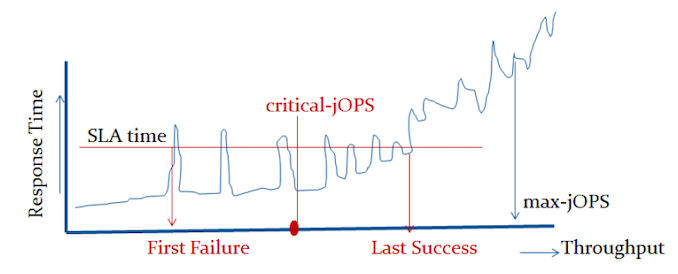
That’s a lot of technicalities to explain an admittedly complex benchmark, but the gist of it is that max-jOPS represents the maximum transaction throughput of a system until further requests fail, and critical-jOPS is an aggregate geomean transaction throughput within several levels of guaranteed response times, essentially different levels of quality of service.
Beyond the result figures, the benchmark keeps detailed track of timings of responses and tracks a few important statistical data-points across a response-time curve, as follows:
Comparing the Xeon 8380 to the Xeon 8280, what’s to be immediately noted is the much-improved maximum throughput figure of the new part, scaling at +64% compared to its predecessor. We’re seeing that the load slope where the 99th percentile SLA figures rises comes in at a relative earlier point, and the corresponding critical-jOPS point lands in relatively earlier than the Xeon 8280.
I included the AMD EPYC 7763 and Altra graphs for context.
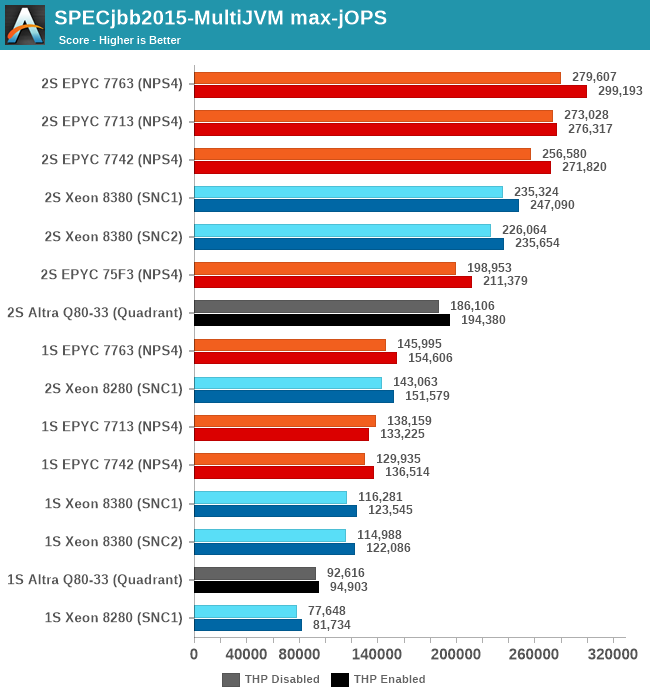
My theory here is that because of the good per-core performance of the Intel design, along with the monolithic mesh architecture, while Intel doesn’t quite catch up with AMD, it performs very well with relatively significantly fewer cores.
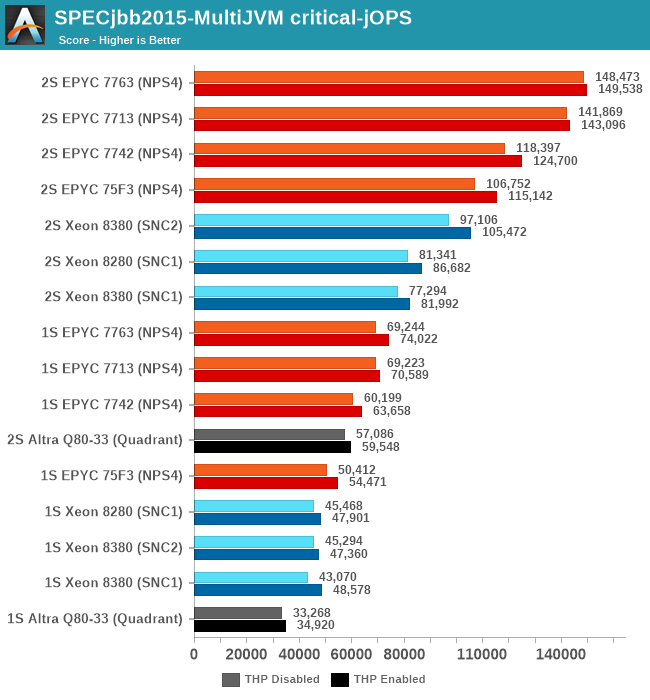
What’s really odd about the results though is that this larger increase only happens in the 2S test figures, with the 1S being unfavourable to the new Ice Lake part, losing to the 8280 in both modes. I had repeated these numbers several times to be sure they’re repeatable, and they were indeed so – as odd as that is. The 1S reduction in the critical-jOPS could be explained through the larger mesh size and larger core count of the 8380, and we did see slight regressions in core-to-core latencies. If the mesh intersection bandwidth did not increase with its size, that also could be a culprit of these figures, as the workload is hammering core-to-core transactions as well as the L3 cache of the chip.
Why the 2S figures see a bigger advantage of migrating to SNC2 could be a result of how on-chip traffic is routed, as well as the traffic flows through the UPI link blocks of the chip – at least that would be my working hypothesis.
Intel had disclosed a +62% figure for a “Java Throughput under SLA” workload they wouldn’t specify, and this does track well with our max-jOPS results. While the critical-jOPS increases seem a bit disappointing generationally, how it translates to the real world in contrast to the max-jOPS figure depends on how strict one’s SLA metrics are.


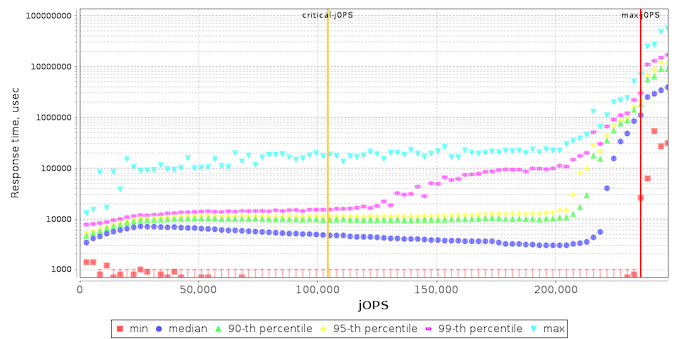
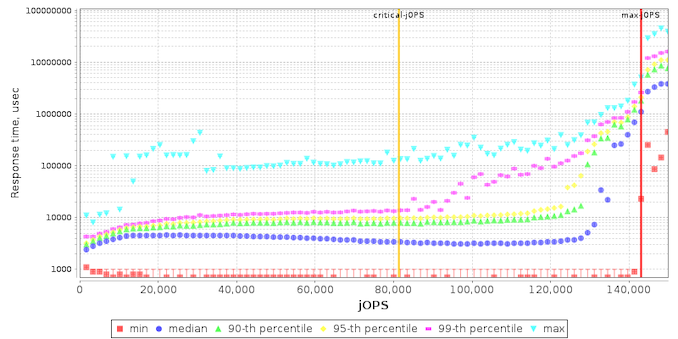
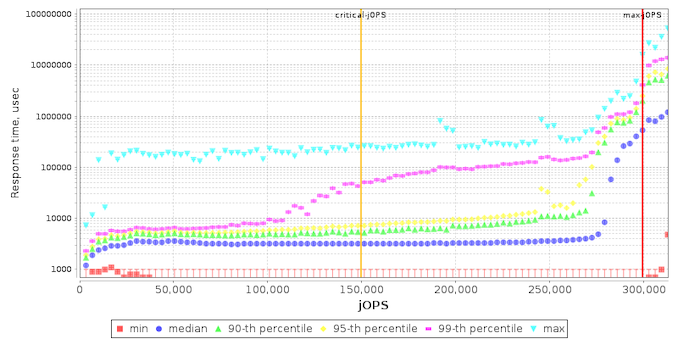
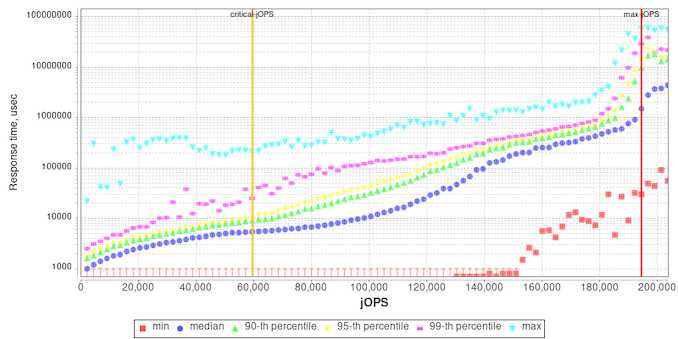








169 Comments
View All Comments
Drazick - Wednesday, April 7, 2021 - link
The ICC compiler has much better vectorization engine than the one in GCC. It will usually generate better vectorized code. Especially numerical code.But the real benefit of ICC is its companion libraries: VSML, MKL, IPP.
Oxford Guy - Wednesday, April 7, 2021 - link
I remember that custom builds of Blender done with ICC scored better on Piledriver as well as on Intel hardware. So, even an architecture that was very different was faster with ICC.mode_13h - Thursday, April 8, 2021 - link
And when was this? Like 10 years ago? How do we know the point is still relevant?Oxford Guy - Sunday, April 11, 2021 - link
How do we know it isn't?Instead of whinge why not investigate the issue if you're actually interested?
Bottom line is that, just before the time of Zen's release, I tested three builds of Blender done with ICC and all were faster on both Intel and Piledriver (a very different architecture from Haswell).
I asked why the Blender team wasn't releasing its builds with ICC since performance was being left on the table but only heard vague suggestions about code stability.
Wilco1 - Sunday, April 11, 2021 - link
This thread has a similar comment about quality and support in ICC: https://twitter.com/andreif7/status/13808945639975...KurtL - Wednesday, April 7, 2021 - link
This is absolutely untrue. There is not much special about AOCC, it is just a AMD-packaged Clang/LLVM with few extras so it is not a SPEC compiler at all. Neither is it true for Intel. Sites that are concerned about getting the most performance out of their investments often use the Intel compilers. It is a very good compiler for any code with good potential for vectorization, and I have seen it do miracles on badly written code that no version of GCC could do.Wilco1 - Wednesday, April 7, 2021 - link
And those closed-source "extras" in AOCC magically improve the SPEC score compared to standard LLVM. How is it not a SPEC compiler just like ICC has been for decades?JoeDuarte - Wednesday, April 7, 2021 - link
It's strange to tell people who use the Intel compiler that it's not used much in the real world, as though that carries some substantive point.The Intel compiler has always been better than gcc in terms of the performance of compiled code. You asserted that that is no longer true, but I'm not clear on what evidence you're basing that on. ICC is moving to clang and LLVM, so we'll see what happens there. clang and gcc appear to be a wash at this point.
It's true that lots of open source Linux-world projects use gcc, but I wouldn't know the percentage. Those projects tend to be lazy or untrained when it comes to optimization. They hardly use any compiler flags relevant to performance, like those stipulating modern CPU baselines, or link time optimization / whole program optimization. Nor do they exploit SIMD and vectorization much, or PGO, or parallelization. So they leave a lot of performance on the table. More rigorous environments like HPC or just performance-aware teams are more likely to use ICC or at least lots of good flags and testing.
And yes, I would definitely support using optimized assembly in benchmarks, especially if it surfaced significant differences in CPU performance. And probably, if the workload was realistic or broadly applicable. Anything that's going to execute thousands, millions, or billions of times is worth optimizing. Inner loops are a common focus, so I don't know what you're objecting to there. Benchmarks should be about realizable optimal performance, and optimization in general should be a much bigger priority for serious software developers – today's software and OSes are absurdly slow, and in many cases desktop applications are slower in user-time than their late 1980s counterparts. Servers are also far too slow to do simple things like parse an HTTP request header.
pSupaNova - Wednesday, April 7, 2021 - link
"today's software and OSes are absurdly slow, and in many cases desktop applications are slower in user-time than their late 1980s counterparts." a late 1980's desktop could not even play a video let alone edit one, your average mid range smartphone is much more capable. My four year old can do basic computing with just her voice. People like you forget how far software and hardware has come.GeoffreyA - Wednesday, April 7, 2021 - link
Sure, computers and devices are far more capable these days, from a hardware point of view, but applications, relying too much on GUI frameworks and modern languages, are more sluggish today than, say, a bare Win32 application of yore.